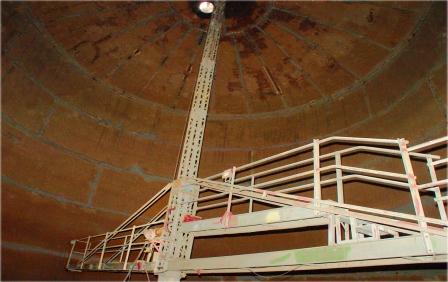With the evolution of California wines becoming a major presence in the worldwide market, production and infrastructure needed to protect the fruits of a precious multi-billion dollar industry, which often comes down to a good coating. So when a Central California vintner (that chooses to remain unnamed) needed to clean and recoat its wine storage tanks, the who (i.e., which contractor) and the what (i.e., which coating) was crucial.
Norm Bahr of American Foam Experts was chosen to tackle the job with what would eventually end up as an Advanced Polymers lining.
Quality Assurance
While this is now an ongoing project, the initial job consisted of two 640,000-gallon (2,422,664 L) and two 350,000-gallon  (1,324,894 L) wine tanks. All tanks were to be coated with corrosion-resistant, food-grade material that could withstand anything from 200-proof alcohol to caustic waste water. The only problem? The best product for the job didn’t exactly exist at the time.
(1,324,894 L) wine tanks. All tanks were to be coated with corrosion-resistant, food-grade material that could withstand anything from 200-proof alcohol to caustic waste water. The only problem? The best product for the job didn’t exactly exist at the time.
“I went to conventions going booth to booth trying to find something that could handle the corrosive nature of pure wine but also be food safe and not affect the taste and quality of the wine,” Bahr explained. “So we worked with Advanced Polymers to develop the right product for the client.”
Bahr had originally begun work with the winery in question installing foam insulation on the exterior of the tanks, and he began doing some of the interiors as well. “They had used other products and were getting certain tastes and smells that affected wine quality, so we decided that we needed to come up with a better solution,” noted Bahr. Not only did the product have to be durable and food safe, but it had to be able to handle everything from fermentation to storage, as well as to hold pure alcohol to augment fermented spirits. And it’s worth stating, as Bahr did, that “alcohol is very aggressive to exterior coating materials.” So that lining needed to be perfect.
By working closely with the client and the product manufacturer, the team went through six months of research, development, and testing to ensure the final formula met the stringent food safety criteria, which in this case was zero parts per billion of any solvents from the product. Advanced Polymers’ existing product, ChemLine Formulation 784-32 met the base challenges of the corrosive material storage but not the guideline of the solvent carrier into the stored wine. As a result, a new formulation was created with methanol (200-proof alcohol) so the taste and quality of the wine stored in the tanks would not be affected.
What’s a wine without the right taste and quality, after all?
Special Mix
The American Foam Experts crew consisted of four men, with one person dedicated as a safety monitor to ensure that procedures were properly followed in the confined space, as well as special safety equipment properly used to measure carbon dioxide, oxygen, and sulfur dioxide.
Preparation of the tanks included cleaning the interior with a caustic agent mixed with water, followed by sandblasting the interior to a fine metal finish. Application had to be done from an internal scaffolding system that elevated from a center pivot, placed through a 24-inch-by-18-inch (61 cm x 46 cm) access hole, which itself took two full days to assemble. The tanks themselves were nearly pitch black inside, so explosion-proof lighting was also added to safely complete the installation. With the interior surface prepped, the crew was ready to move on to the coating.
American Foam Experts sprayed the product in two coats. It was applied at 0.6 inches (15 mm) per coat and needed to be heat cured in order to properly harden. Manufacturer’s specifications called for 250° F (121° C) for 8 hours, but Bahr had to reduce the temperature and lengthen the cure time in order to prevent damage to the existing foam insulation on the tanks. As a result, Bahr found that 160° F (71° C) for 30 hours, facilitated by Hotwork, a third party vendor, was the best temperature and duration.
The curing process, in addition to the 110° F (43° C) summer heat, led to much of the work being done at night. “One of the problems we had with the heat,” added Bahr, “was that eventually we lost a few of the freezers used to pre-cool the chemical before we mixed it. We discovered that the plural component product cooled to 65° F [18° C] would have a 1.5-hour pot life rather than just 10 minutes.” After curing, the crew used what they called a “sparker” that, as Bahr describes, “arcs a spark between the steel, that way we verified we had a completely covered surface texture.”
Positive Notes
The end result of the tweaks and customizations was that the coatings offered the right harmony of safety and durability and, thanks to the collaboration between American Foam Experts, Advanced Polymers, and the client, the group as a whole was able to create a solution to a unique and demanding problem.
Now in their third year of working with the winery, Bahr and his team have earned some valuable word-of-mouth accolades from other wineries curious about this long lasting coating treatment for their own carbon steel wine tanks. Because of that, Bahr and the American Foam Experts team recoat approximately four to six tanks per winery client per year.
Hey! That’s a lot of wine.
